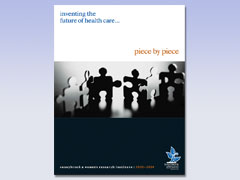Spotlight on Breast Cancer Research: Cutting to the Core of the Issue
Dr. Don Plewes is also part of a group studying the use of imaging in surgery. "I've always been impressed when I see breast MR images," he says. "I see these beautiful images that give such exquisite detail of the tumour that it seems a shame we use (MRI) only for diagnosis and detection. Is there not some way we can use it to facilitate therapies with real impact?"
Quite possibly. Currently, surgeons must rely on where a radiologist has preoperatively placed a blob of dye or a fine wire to know where a tumour is and where to cut. "That doesn't really give us a clear picture in three dimensions as to exactly where the edge of the tumour is," says Dr. Claire Holloway, a surgical oncologist at Sunnybrook & Women's since 1993.
The idea instead is to use imaging modalities – MR and ultrasound, for example – to plan and guide the surgery in real-time. "We would like to be able to mark the edges of the tumour in a way that makes it easier to see with ultrasound. It's not always easy to see where the tumour starts and ends. Some aren't even visible on ultrasound," says Holloway, the study's principal investigator. Plewes is developing markers that can pinpoint these edges, rather than only one spot in the middle.
To what benefit? "This would make the surgical procedures more precise, more accurate in terms of knowing where we should be confidently defining that surgical margin, and hopefully reduce the required re-excisions," Plewes says. It also can be used to verify that everything was removed, without the usual time- and labour-intensive trips to an X-ray lab, Holloway notes.
"If we can do this right then and there as we're taking the tumour out, we can say, 'OK we've got it ... we're sure that we've got it;' this minimizes the need for a second operation and makes for more efficient use of scarce resources."
She's been doing image-guided surgery in S&W's experimental operating room for one year – about 100 operations. At this developmental stage, she's using ultrasound to see what the tumours' edges look like. The use of markers with ultrasound will be tested next.
The surgical oncology department is an active one. Over the last two years, she's been involved in several multicentre clinical trials, including the pivotal trial known as NSABPB-32 that is testing the effectiveness of sentinel lymph node biopsy, another procedure where technology has been incorporated into surgery to minimize the short- and long-term effects of breast cancer treatment.
Holloway says it's been an exciting few years for breast cancer research at SWRI, the more so because of the team approach. "Modern-day research cannot be done by investigators in isolation," she asserts. "It's clear to me that we make our best contributions by developing collaborations with people with different expertise. That's what's so great about this group."
The breast MRI study is funded by the Canadian Breast Cancer Research Alliance and The Terry Fox Foundation. The image-guided surgery research is funded by the Canada Foundation for Innovation, the Ontario Research and Development Challenge Fund and The Terry Fox Foundation.
PDF / View full media release »


